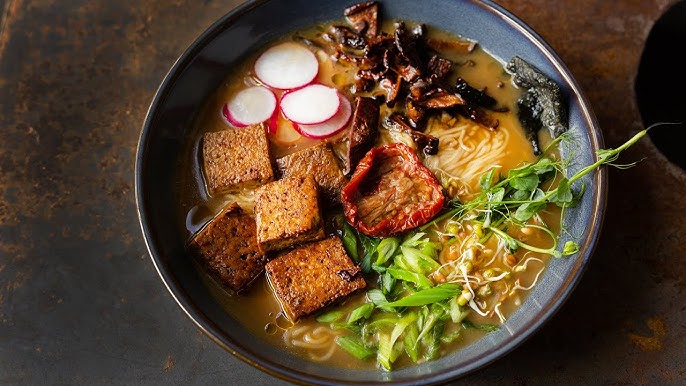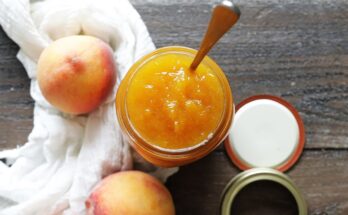Vegan Ramen Recipe: Let’s face it—ramen has taken the world by storm. But when most people think of ramen, they usually imagine bowls brimming with pork-based broth, eggs, and meat toppings. That’s where vegan ramen comes in—a plant-powered version that’s just as comforting, rich, and full of umami flavor.
Vegan ramen is a Japanese-inspired noodle soup that replaces traditional animal-based ingredients with plant-based alternatives. The result? A hearty, flavorful, and soul-warming bowl that fits a vegan lifestyle without sacrificing taste. Whether you’re a committed vegan, trying out Meatless Mondays, or just looking to lighten your meals, vegan ramen is the perfect one-bowl meal to add to your rotation.
Why Choose Vegan Ramen?
There are a bunch of great reasons to dive into a hot bowl of vegan ramen. First, it’s incredibly versatile. You can mix and match ingredients based on what you have in your fridge, your taste preferences, or what’s in season. Plus, it’s surprisingly easy to make at home once you’ve got the basics down.
Secondly, it’s lighter on your digestion. Compared to the traditional fatty and rich tonkotsu broths, vegan ramen often uses miso, mushroom, or soy milk bases. These are easier on the stomach but still deliver that signature ramen umami.
And finally, it’s more sustainable. A bowl of vegan ramen leaves a lighter carbon footprint than meat-heavy versions, making it a smart and ethical choice for environmentally conscious eaters.
Health Benefits of Vegan Ramen
Believe it or not, vegan ramen can be super healthy—especially when you make it at home. You control the salt, the oil, and the toppings. By using whole-food ingredients, you’re packing in vitamins, minerals, and fiber that your body loves.
Here’s what you get with a good homemade vegan ramen:
- High fiber from fresh veggies and whole wheat noodles
- Healthy fats from sesame oil or avocado oil
- Plant-based protein from tofu, tempeh, or edamame
- Antioxidants from garlic, ginger, mushrooms, and greens
So it’s not just comfort food—it’s fuel that keeps you energized and satisfied.
Ingredients You’ll Need
Essential Base Ingredients
Your broth is the soul of your ramen. For a rich vegan ramen, you’ll want to use a combination of the following:
- Miso paste (white or red)
- Soy sauce or tamari (for gluten-free)
- Vegetable broth (low-sodium preferred)
- Sesame oil
- Garlic and ginger (fresh is best)
- Green onions or scallions
- Dried seaweed (kombu or wakame)
- Mushrooms (shiitake or cremini work great)
These ingredients create a deep umami flavor that mimics the richness of traditional ramen broth without the meat. You can simmer the broth with kombu and mushrooms for 20–30 minutes for an extra layer of flavor.
Vegetables for Flavor and Nutrition
The beauty of ramen is that it’s a canvas—and your veggies are the paint. You can customize based on what’s in your fridge, but here are some top picks:
- Baby bok choy
- Carrots (julienned)
- Corn kernels
- Spinach or kale
- Bean sprouts
- Napa cabbage
- Zucchini or mushrooms
Sauté them, blanch them, or even roast them before adding to the bowl for extra flavor and texture.
Protein Options (Tofu, Tempeh, etc.)
A good vegan ramen doesn’t leave you hungry—and plant protein is the secret.
- Tofu – pan-fried or baked until crispy
- Tempeh – marinated and grilled
- Edamame – quick and easy protein
- Seitan – for a meatier texture
- Vegan chick’n strips – optional but delicious
For the ultimate crunch and flavor, toss tofu in cornstarch before pan-frying in sesame oil.
Toppings and Garnishes
Toppings are where you can get creative. They add texture, color, and fun to your ramen experience. Here are some crowd-pleasers:
- Nori sheets – cut into strips
- Toasted sesame seeds
- Green onions – sliced thin
- Chili oil or sriracha
- Pickled ginger
- Lime wedges
- Furikake (vegan version)
Remember, half the ramen experience is in the presentation, so don’t skip the garnish!
Optional Add-ins and Substitutions
Don’t have all the ingredients on hand? No problem. Here are a few swaps and additions:
- Swap noodles – use soba, udon, or even rice noodles if needed
- Add coconut milk – for a creamy, Thai-style ramen
- Use peanut butter or tahini – for a nutty twist
- Add fermented foods – like kimchi for gut-boosting benefits
- Fresh herbs – like cilantro or Thai basil for flavor punches
The key is making it your own while sticking to a plant-based, nourishing base.
Step-by-Step Vegan Ramen Recipe
Step 1: Preparing the Broth
In a large pot, heat sesame oil and sauté garlic, ginger, and onions until fragrant. Add vegetable broth, soy sauce, miso paste, and a splash of rice vinegar. Simmer for 15–20 minutes to deepen the flavor.
Step 2: Cooking the Noodles
Boil ramen noodles (fresh or dried) in a separate pot according to package directions. Drain and toss lightly with oil to prevent sticking.
Step 3: Prepping and Cooking the Toppings
Pan-fry tofu cubes, mushrooms, and bok choy until golden and tender. Steam or roast any additional veggies like carrots or corn.
Step 4: Assembling the Ramen Bowl
Place noodles in a bowl, ladle hot broth over them, and arrange the toppings neatly on top.
Step 5: Final Touches and Serving Tips
Garnish with green onions, nori strips, and sesame seeds. Serve hot with chili oil or lime wedges for extra zing—comforting, flavorful, and fully plant-based!
Customization Tips
Spice It Up: Make it Spicy or Mild
Everyone’s heat tolerance is different, and ramen is the perfect dish to personalize. If you love spice, add:
- Chili oil or chili crisp (adds flavor and texture)
- Fresh sliced chilies like Thai bird’s eye or jalapeños
- Sriracha or hot sauce
- Red pepper flakes sprinkled over the top
To keep things mild, leave the chili on the side. Miso and soy sauce provide enough flavor without heat. For a smoky twist, try adding smoked paprika or a splash of liquid smoke to the broth.
You can also divide the broth into two portions—spice one and leave the other mild. That way, everyone gets what they like.
Gluten-Free or Low-Carb Versions
Don’t worry if you’re avoiding gluten or carbs—vegan ramen can be adapted easily.
For Gluten-Free:
- Use rice noodles, glass noodles, or certified gluten-free ramen noodles
- Replace soy sauce with tamari or coconut aminos
- Double-check miso paste—it should be gluten-free, but always read the label
For Low-Carb/Keto:
- Try zucchini noodles (zoodles), shirataki noodles, or kelp noodles
- Use a broth made with unsweetened almond milk or light coconut milk to reduce carbs
- Focus on high-fiber veggies and tofu for fullness
These versions still deliver on flavor and satisfaction, minus the gluten or carbs.
Regional Ramen Twists
Ramen is flexible, and many regions have their own spin. Here are some ways you can get creative with global inspirations:
- Thai-Inspired Ramen: Use coconut milk, red curry paste, lime juice, and cilantro
- Korean Ramen: Add kimchi, gochujang, and sesame seeds
- Chinese-Inspired: Toss in Chinese broccoli, hoisin sauce, and black vinegar
- Fusion Ideas: Think peanut butter + sriracha + soy sauce for a spicy peanut broth
Don’t be afraid to step outside the Japanese flavor box. As long as the bowl’s delicious and comforting, you’re doing it right.
Nutritional Breakdown
Macronutrient Analysis
One of the best parts about vegan ramen is how nutritionally balanced it can be—especially when made at home. It’s not just a bowl of noodles in broth; it’s a complete meal offering all your macronutrients: carbs, protein, and healthy fats, with a good dose of fiber and vitamins on top.
Here’s a rough breakdown per serving (based on a standard bowl with miso broth, noodles, tofu, and veggies):
- Calories: 450–550 kcal
- Carbohydrates: 45–60g
- Protein: 18–25g
- Fat: 15–20g
- Fiber: 6–10g
The carbs primarily come from noodles and veggies, fueling your body with quick energy. The protein content—mainly from tofu, tempeh, or edamame—is ideal for muscle repair and staying full longer. Healthy fats come from sesame oil, tahini, or avocado toppings, helping with nutrient absorption.
Want to boost protein? Add more tofu, edamame, or even sprinkle hemp seeds on top. Need more fiber? Throw in extra greens, mushrooms, or cruciferous veggies like broccoli.
Compared to traditional ramen (which can be high in sodium, fat, and cholesterol), vegan ramen is a lighter, more nutritious alternative. And when you’re in control of the ingredients, it’s easy to cater it to your dietary needs—whether you’re aiming to lose weight, build muscle, or simply eat clean.
Caloric Content Per Serving
Let’s take a closer look at a typical homemade vegan ramen bowl’s calorie distribution:
| Ingredient | Amount | Calories |
|---|---|---|
| Ramen noodles (100g) | 1 serving | 190–220 |
| Vegetable broth (2 cups) | 480ml | 20–40 |
| Tofu (100g) | 1/2 block | 120–150 |
| Mixed vegetables | 1 cup | 50–80 |
| Miso paste (1 tbsp) | 15g | 35–45 |
| Sesame oil (1 tsp) | 5ml | 40 |
| Garnishes & extras | – | 20–40 |
Total per bowl: Around 475–575 calories, depending on how generous you are with portions and oil.
This makes vegan ramen not just comforting and delicious, but also a healthy, energy-sustaining meal perfect for lunch or dinner.
Storage and Meal Prep Tips
Storing Leftovers
Made too much ramen? Happens to the best of us. Good news—you can store leftovers smartly to enjoy them later without losing that fresh, delicious flavor.
Rule #1: Store components separately.
If you’ve already mixed everything together, the noodles will likely soak up all the broth and become soggy. Instead, store the broth, noodles, and toppings in separate airtight containers. Here’s how long each lasts:
- Broth: Up to 5 days in the fridge
- Cooked noodles: 2–3 days (rinsed with cold water and lightly oiled)
- Veggies and toppings: 3–4 days, depending on the ingredient
- Tofu or tempeh: 3–4 days when refrigerated in an airtight container
When you’re ready to eat, simply reheat the broth to a simmer, warm the toppings, and pour it all over your noodles. Instant homemade ramen!
Freezing Instructions
Want to prep ramen ahead of time and freeze it? Absolutely doable—with a few guidelines.
Broth: This is the easiest part to freeze. Let it cool completely, then transfer to freezer-safe containers or zip-top bags. It keeps well for up to 2 months. You can even freeze in individual portions for easy defrosting.
Tofu/Tempeh: Cooked tofu can be frozen, but the texture becomes more sponge-like—which some people love. Tempeh freezes beautifully. Just cool completely and store in a sealed container.
Veggies: Avoid freezing raw veggies. If you want to freeze them, blanch or roast them first. Leafy greens may wilt upon thawing, so freeze heartier vegetables like mushrooms, corn, or carrots.
Noodles: Freezing cooked noodles is tricky—they tend to get mushy. If you must freeze them, undercook slightly and store with a splash of oil to reduce clumping.
Make-Ahead Components
Meal prepping vegan ramen is all about smart planning. Here’s a sample make-ahead plan:
Sunday:
- Make a big batch of miso broth and freeze half
- Cook tofu and store it in the fridge
- Prep and chop all veggies
Midweek:
- Boil noodles fresh (takes 5 minutes)
- Reheat broth and toppings
- Assemble a hot, fresh bowl in under 10 minutes
This strategy works great for busy professionals, students, or anyone wanting quick, homemade meals during the week.
FAQs about Vegan Ramen Recipe
Can I make vegan ramen without miso?
Absolutely. While miso adds depth and that classic umami flavor, you can replace it with tahini, soy sauce, or even peanut butter for a different twist. A broth made with mushrooms, garlic, ginger, and soy sauce still delivers rich flavor without miso.
What type of noodles should I use for vegan ramen?
Traditional ramen noodles work best, but make sure they don’t contain eggs (check the label). For a healthier or allergen-friendly option, go for soba, udon, or rice noodles. Zucchini noodles or shirataki are great for low-carb versions.
How do I make vegan ramen spicy?
Spice it up with chili oil, sriracha, red pepper flakes, or fresh sliced chilies. You can also stir in a bit of gochujang (Korean chili paste) or make a spicy sesame broth using chili garlic sauce.
Is vegan ramen suitable for kids?
Yes! Just skip the spicy toppings and keep flavors mild. Let kids choose their own toppings from a selection of colorful veggies, tofu, and fun garnishes. It’s a great way to get them involved and interested in plant-based meals.
Can I make the broth ahead of time?
Definitely. In fact, the broth often tastes better the next day after the flavors have melded. Store in an airtight container in the fridge for up to 5 days or freeze in portions for future use.
Conclusion
Vegan ramen isn’t just a dish—it’s a warm hug in a bowl. From the rich miso or mushroom broth to the customizable toppings and protein-packed tofu, this is one recipe that never gets boring. Whether you’re fully vegan, plant-curious, or simply trying to eat healthier, mastering this dish is a game-changer.
With a handful of pantry staples, some fresh produce, and a little creativity, you can whip up your own restaurant-worthy ramen at home. It’s healthier, cheaper, and tailored to your exact taste.
So next time the craving hits, skip the takeout and build your own bowl. Trust me—once you taste how good vegan ramen can be, you’ll never look at instant noodles the same way again.



